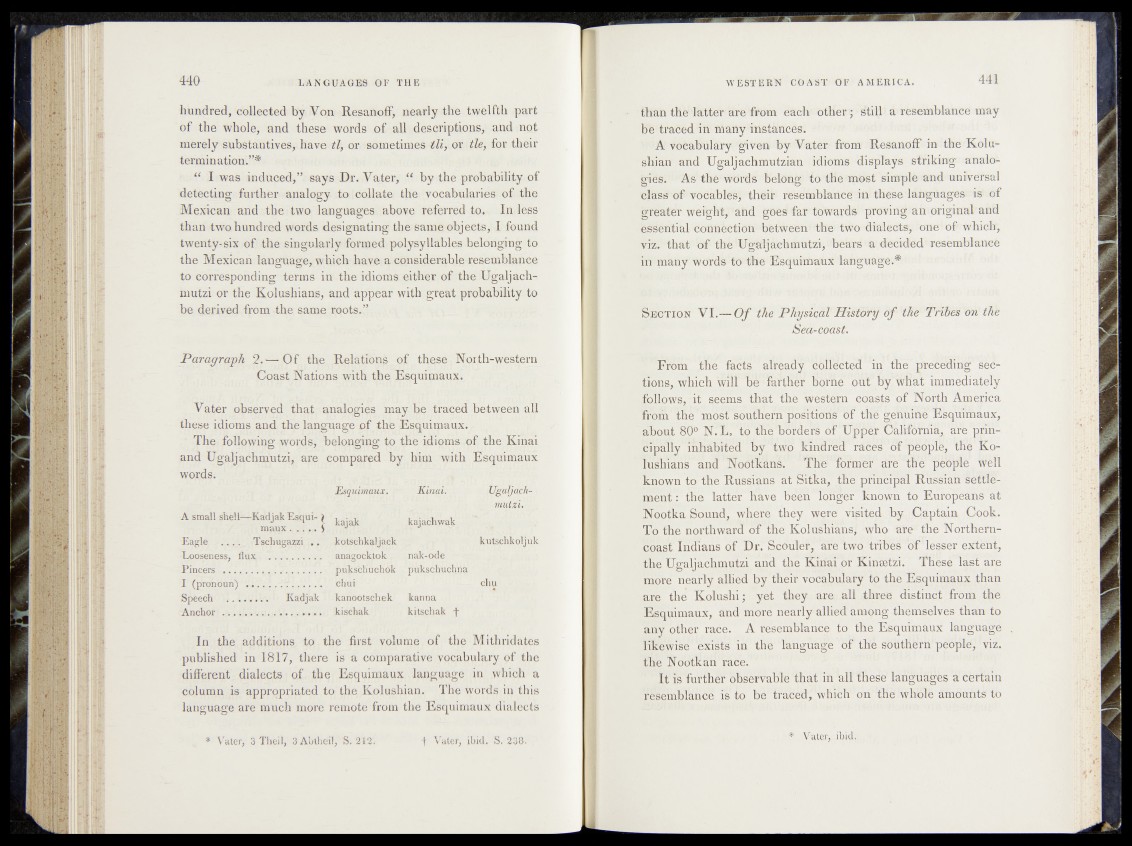
hundred, collected by Von Resanoff, nearly the twelfth part
of the whole> and these words of all descriptions, and aipt
merely substantives,; have or, sometimes, tZi, or tie. Son their
k. “ I was induced*”$ says Dr, V ater, by the probability of
detecting further analogy to ; collate the-yocabulariesuof the
Mexican and tithei two languages above referred to. In. less
than two hundred words designating the same objects, I found
twenty-six of thesi®gularly formed polysyllables belonging to
the Mexican language* which havesa considerable-resemblance
to corresponding terms in the idioms either of the Ugaljach-r
niutzi or the Kolushians, and appear with great probability to
be derived from the same roots.”
Paragraph 2. — Of the Relation^ of these. North-western
Coast Nations with the Esquimaux.
Vater observed that analogies may-be traced between all
these idioms and the language of the Esquimaux.
The. following words, belonging to the idioms of. the Kinai
and Ugaljachmutzi, are compared by him with Esquimaux
words.
E s q u im a u x . ' K in a i. P gtA iapM -
m u lz i. ,
A small shetL-Kadjak Esqui-1 k| | | kajachw^
| , maux . . . . . . 5 m m u m ■ «iff
Eagle . . . . Tschugazzi . . kotschkaljack , kutschkoljuk
Looseness, flux ............ ... anagocktok . .nak-ode -
Pincers . . . . . . . pukschüchök pukschuchna
I (prmioun) ,-i*i. . . . . . . cliui chu
Speech .. . .:ö ï|g ] Kâdjiak kanootschek kanna
Anchor........... ................... kisehak kitschak f
In the additions to the first volume of the Mithridates
published in 1817, there fs a comparative vocabulary of the
different dialects q f the Esquimaux -language in which a
column is appropriated to the Kolushian. The words in this
language are much more remote from the Esquimaux dialects
* Vater, 3 Theil, 3 Abtheil, S. 212'. f Vater, ibid. S. 238.
than thfe;-latter are from each? otHer; 1 still a resemblance may
bh'traced in tnany 'iristanceSi 14
; > -A f b l h ^ t e y V a t e r from Resanoff in the Kolu-
sliian and Ugaljachmutzian idioms displays striking analo-
'g-ies^^As the w’dr'ds belong to the most simple and universal
clhs^ of vodaibl^ thCif i&fed&blafieddfll 4h#se‘lahgdagesi-is> of
'greater weight, ahd goe^faf ' towardo.i proving ah'original and
"fefeserftial connfectiOtf bef^ighbbhe1 '‘one of whic%
viz. that of the *TLFgS:lj4'ch rhutzi, -bears a diecMfed resemblance
in many'vvords to the Esquimaux language.*
S e c t io n VI.— O f the PhysiçâV Hisffirÿ öf HM the
tSeâ-coast.
From tné facts, already ’collected in' fhe”rp"receaîhg Sections,
which will be farther immediately
follows, it seems that the western coasts pf North America
from' the móst southern positions of trie'genuine Esquimaux,
ab,opt 80° N?L. to the'b'orders of Upper California^1 are principally’
inhabited by two kindred races°of people, the Ko-
lusmans ancT Nootxans. T h e1 former dre the'people well
known to the Russians 'aTSitka, the principal Russian Settlement:
3 the latter have been'longer known to Europeans at
Nootka Sound, where they were vipited by Captain ,Cook.
To the northward of the Kolushians;' who ate^the Northern-
coast Indians of Dr. Scóuler, are Awo trihe^ of leper extent,
the Ugaljachmutzi and the Kinai- or Kinætzi. Theselast are
more nearly allied by their vocabulary to the Esquimaux than
are the Kolushlll yet they, are- all three distinct from the
Esquimaux, and more nearly allied anapng themselves than to
any other race. A resemblance to the Esquimaux language
likewise’ exists in the language of th’è sbüthërntpê,ó'pld|lviz.
the Nóbtkah face.
' It is further obsèrvable that an a lf these lâhguâ^ès a certain
ÿèVemblatici is to b’è’Tfàbefl, wh]&h,Tdn ‘thé whÓïb atnööïitó to
1 Vater, ibid,..